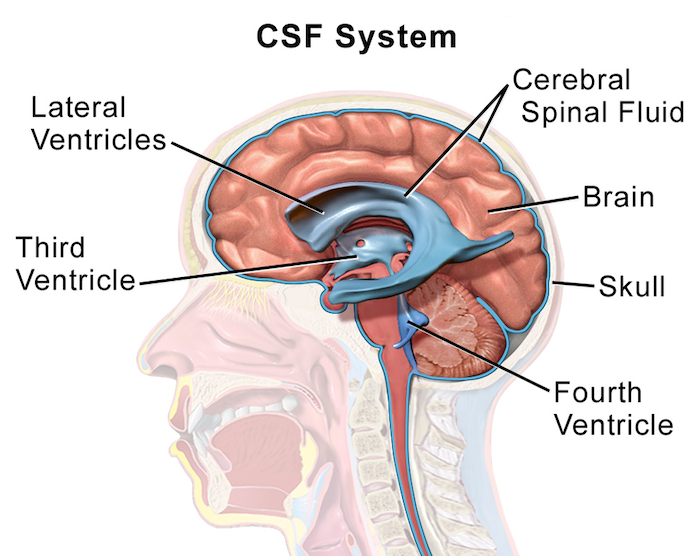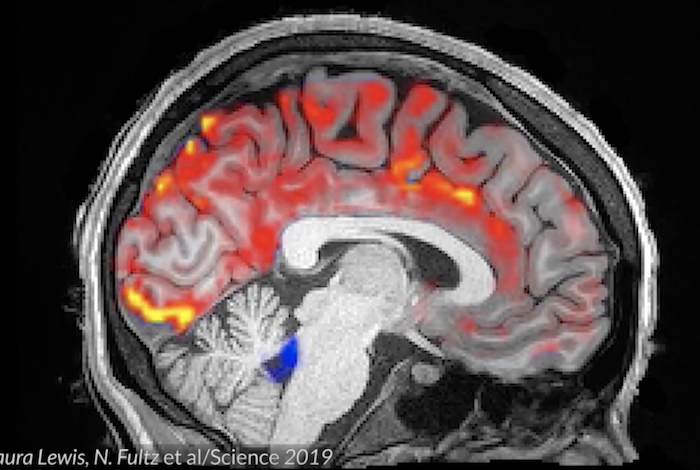Everyone knows that a good night’s sleep is vital to physical and psychological health, but understanding exactly what is happening in our brains as we dream has been an enduring challenge. Scientists have long suspected that cerebrospinal fluid (CSF), the clear, watery substance that surrounds and protects the brain and spinal cord, might play a vital role in how well we sleep.
Now researchers have uncovered how part of this nightly reset works. As we sleep our brains are bathed in waves of cerebrospinal fluid that literally flush out dangerous biological waste and toxins that have accumulated during our waking hours. In essence, the brain is taking out the garbage while we slumber.
And where does all this brain garbage come from? Even though the brain only accounts for 2 percent of the body by weight, this power-hungry organ uses up about 20 percent of the body’s daily energy intake to fuel its activities. And burning through so much fuel generates a lot of biological waste in the process. Two types of waste products are particularly worrisome: beta-amyloid peptides and sticky tau proteins that can accumulate in the brain to form the damaging tangles and clumps implicated in Alzheimer’s and other degenerative diseases.
Obviously, all human brains produce metabolic waste products during the day, yet neurodegenerative diseases are rarely seen in young people.
This may be because young people generally manage to get more sleep, and in particular, more of a specific type of sleep needed to flush out brain toxins, than older people.
Previous studies with mice have shown that slow electrical oscillations (or “slow waves”) that characterize deep, non-REM sleep are linked to lowered levels of toxic brain waste products after a good night’s sleep. Now, for the first time, neuroscientist and sleep researchers from Boston University have shown how this process works in humans.
Lead author Laura Lewis and her colleagues wanted to get a comprehensive picture of how the brain was clearing these waste products during sleep. “We know sleep is really important for brain health, and waste clearance is probably a key reason why; what was less clear is: Why is this changed during sleep?” asked Lewis. “That led us to ask what was happening in the cerebrospinal fluid.”
 To answer this, they fitted 13 healthy adults with EEG caps to monitor their neural activity while they slept. Additionally, they observed the subject’s cerebrospinal fluid activity by having them sleep inside an MRI. Together the scans revealed a series of regular, simultaneous waves of cerebrospinal fluid pulsing through the brain during non-REM sleep (Slow-Wave Sleep).
To answer this, they fitted 13 healthy adults with EEG caps to monitor their neural activity while they slept. Additionally, they observed the subject’s cerebrospinal fluid activity by having them sleep inside an MRI. Together the scans revealed a series of regular, simultaneous waves of cerebrospinal fluid pulsing through the brain during non-REM sleep (Slow-Wave Sleep).
As the fluid flowed into the fourth ventricle, one of four fluid-filled cavities in the brain that produces cerebrospinal fluid, the team watched as CFS circulated between brain membranes to flush out toxic waste products.
“First you would see this electrical wave where all the neurons would go quiet,” said Lewis. A few seconds afterwards “there are these really large, slow waves, occurring maybe once every 20 seconds, of cerebrospinal fluid washing into the brain.” The result was that the pulsing waves of fluid washed away all of the metabolic waste products that had accumulated in the brain during the day (click to see video).
Some researchers have wondered why the brain doesn’t simply flush out these toxins all the time, but Lewis and her researchers have a good idea as to why this only occurs during deep sleep. As the brain’s neurons go quiet during deep, slow-wave sleep, they require less oxygen. Since they require less oxygen, less blood flows to these regions of the brain. With less blood, there’s more space for cerebrospinal fluid to rush in and scrub the brain of its waste products.
“We’ve known for a while that there are these electrical waves of activity in the neurons,” said Lewis, “But before now, we didn’t realize that there are actually waves in the cerebrospinal fluid, too. We’ve discovered there are really large waves of CSF that appear in the brain only during sleep.”
“This effect is really striking, and we’re also interested in what it means for maintaining brain health, especially in disorders such as Alzheimer’s disease.”
The findings have implications for neurodegenerative diseases, which are thought to be caused by build-up of toxic proteins in the brain, such as amyloid-Beta in Alzheimer’s disease. Previous research has shown that amyloid-Beta is cleared more efficiently during sleep, which is often disrupted in Alzheimer’s patients. Disturbances in deep, slow-wave sleep also often accompany aging, which may be linked to cognitive decline.
“We know that people with Alzheimer’s have fewer deep, slow waves, so we may find they also have fewer CSF waves,” Lewis says.
“We have to do these studies now in older adults and patient populations, to understand what this might mean for those disorders.” Sleep disturbance is also a feature of many psychiatric disorders, from depression to schizophrenia. “Different electrical signatures of sleep are disrupted in different psychiatric conditions,” she says. “So this will be very interesting to follow up on in a multitude of disorders.”
Source: Nina E. Fultz, Giorgio Bonmassar, Kawin Setsompop, Robert A. Stickgold, Bruce R. Rosen, Jonathan R. Polimeni, Laura D. Lewis, Coupled electrophysiological, hemodynamic, and cerebrospinal fluid oscillations in human sleep; Science 01 Nov 2019: Vol. 366, Issue 6465, pp. 628-631, DOI: 10.1126/science.aax5440













[…] Source […]